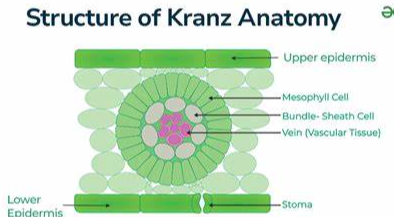chapt 7-photosynthesis
1/7
There's no tags or description
Looks like no tags are added yet.
Name | Mastery | Learn | Test | Matching | Spaced |
|---|
No study sessions yet.
8 Terms
What were the key experiments that led us to understand that plants fix atmospheric carbon and that the oxygen they respire is derived from water?
Joseph Priestly’s experiment:
Plants can “restore” air that has been “injured” by a burning candle or a small animal
Mint plant placed in sealed container with candle and observed
Demonstrate that plants release oxygen, although source of oxygen was not understood yet
Jan Ingenhousz’s experiment:
Expanded on priestly’s work
Plants produce oxygen only in presence of sunlight and green parts of plant
Robert Hill Experiment:
Showed that isolated chloroplasts could produce oxygen when exposed to light in presence of suitable electron acceptor
Confirmed water is source of oxygen in photosynthesis
Ruben and Kamen:
Radiolabeled oxygen in water and showed that O2 released during photosynthesis is also radiolabeled
Why might photosynthesis have evolved to take advantage of such a narrow band of the electromagnetic spectrum?
Absorption spectrum: of a pigment, how much is absorbed at different wavelengths of light (what wavelengths its electrons are excited by)
Action spectrum: how much biological activity for a process there is at different wavelengths
energy efficiency (right amount of energy to excite electrons)
emits most of its energy in visible spectrum
photosynthetic pigments finely absorb visible light efficiently (maximize energy capture and minimize waste)
What are the contributions of the different pigments that are involved in photosynthesis?
chlorophyll a: primary pigment in photosynthesis, absorb light most efficiently in red and blue wavelengths, directly participates in light reactions [light→chemical]
chlorophyll b: accessory pigment, captures blue and red-orange spectrum
carotenoids: include carotenes and xanthophylls, absorb blue and green, meant to pass absorbed light energy to chlorophyll a and protect plant by dissipating excess light energy
How do photosystems I and II absorb light energy and transform it into chemical bonds?
Light dependent reactions
inputs: light, water, NADP+, ADP+
Outputs: O2, NADPH, ATP
photosystem II (PSII):
PSII absorbs light that excites electrons at reaction center P680
splits water molecules, release oxygen, protons, and electrons
electrons passed through ETC, pump proton into lumen and creates the prroton gradient
photosystem I (PSI)
absorb light exciting P700
electrons lost are replenished by those from the PSII by ETC
exctied electrons from PSI used for NADPH formation
What are the roles of Rubisco (in C3 plants) and PEP (in C4 and CAM plants) in the dark reactions, where carbon fixation occurs? What are the pros and cons of separating the light and dark reactions spatially temporally?
“Dark reactions” = calvin or calvin-benson cycle
(C3 plants) Rubisco is the enzyme that catalyzes the linkage of CO2 to 5C RuBP to form a 6C sugar
fixes CO2 in calvin cycle
PEP carboxylasae fixes CO2 into oxaloacetate in C4 and CAM
high affinity for CO2 and does not bind O2, minimizing photorespiration
process occurs in mesophyll cells in C4 plants and fixed CO2 is transported to bundle sheath cells for calvin cycle
CO2 fixation occurs at night for CAM plants, storing as malate for use during the day
C4—
pros: reduce photorespiration by concentrating CO2 in bundle sheath cells and improves efficiency in hot/cold env
cons: require specialized leaf anatomy (Kranz) and additional energy for CO2 transport
CAM—
pros: minimize water loss by fixing CO2 at night when stomata are open, ideal for arid conditions
cons: limit rate of photosynthesis due to storage capacity of malate
kranz anatomy
specialized arrangement found in C4 plants where mesophyll cells form a ring around bundle-sheath cells

What are the inputs and outputs of the light and and dark reactions of photosynthesis, and how are they coupled?
Light reactions
Input: light, ADP, NADP, and H2O
Outputs: ATP and NADPH
Dark reactions (calvin cycle)
Inputs: CO2, ATP, NADPH
Outputs: the 6-carbon sugar PGAL, NADH, ADP, H2O
Photorespiration:
When rubisco catalyzes the fixation of O2 rather than CO2 to RuBP
The glycolate is toxic and must be processed, with a net loss of energy
The result is that some CO2 is lost and neither net ATP nor NADPH are generated
Pros and cons of separating (or not) the light and dark reactions temporally or spatially?
C3- temperate, moist
Rice and tomato
C4 (spatial)- tropics/semitropics, high light, high temp, occasional droughts
Corn, sugarcane
CAM (temporal): deserts and other xeric habitats
Many cacti and other succulents